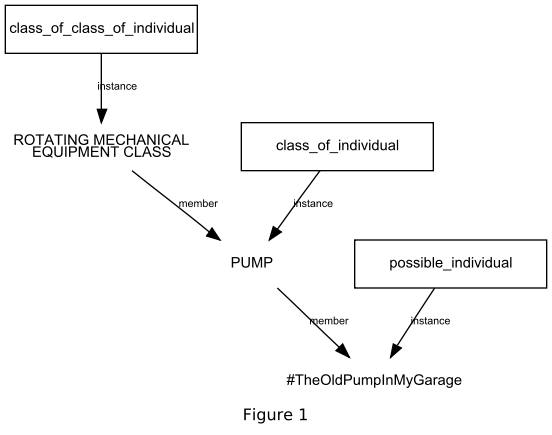| Version 1 (modified by margs, 16 years ago) |
|---|
TracNav menu
Adding membership relationships to ISO 15926-2 in OWL
Status of this document: Sketch
Author:
- Martin G. Skjæveland, DNV
Table of Contents
- Abstract
- Introduction
- OWL representation
- Identified membership relationships in ISO 15926-2
- Candidate membership relationships in ISO 15926-2
Abstract
This article suggests a formalization of the membership relationships expressed more or less informally in the text definition of the entity types of ISO 15926-2:2003 and how they may be expressed in OWL.
Introduction
ISO 15926-2 defines a quite substantial hierarchy of membership relationships. An example of one such sub hierarchy is the following:
A class_of_class_of_individual is a class_of_class whose members are instances of class_of_individual. (ISO 15926-2:2003, p. 166)
A class_of_individual is a class whose members are instances of possible_individual. (ISO 15926-2:2003, p. 117)

Figure 1: An example of a membership hierarchy. #TheOldPumpInMyGarage is a member of PUMP, PUMP is a member of ROTATING MECHANICAL EQUIPMENT CLASS. ROTATING MECHANICAL EQUIPMENT CLASS is an instance of class_of_class_of_individual, PUMP is an instance of class_of_individual and #TheOldPumpInMyGarage is an instance of possible_individual.
However, this hierarchy is not included in the EXPRESS listing of ISO 15926-2 due to what seems to be lack of expressiveness in the EXPRESS language: "It should be noted that the EXPRESS subtypes of class defined in this part of ISO 15926 are instances of class_of_class, though the EXPRESS language specification does not allow this to be stated" (ISO 15926-2:2003, p. 37). This information is naturally therefore not included in the OWL representation of the EXPRESS file. (Read more: ISO15926inOWLtranslateEXPRESStoOWL.) The membership relation/(Classification) is together with the specialization relation the most fundamental way to describe the universe of interest. Capturing this information is thus important to ensure that the ISO 15926-2 data model is used as intended.
OWL representation
The membership relation is represented in ISO 15926-2 using the entity type CLASSIFICATION: classification is a relationship that indicates membership of a class (ISO 15926-2:2003, p. 33). The OWL definition of CLASSIFICATION in the OWL file http://rds.posccaesar.org/2008/02/OWL/ISO-15926-2_2003 is the following
Class: Classification
SubClassOf:
Relationship,
hasClassifier exactly 1 Class,
hasClassified exactly 1 Class
The EXPRESS definition is found here: classification.
[diagram]
The owl:ObjectProperties hasClassified and hasClassifier is defined in ISO 15926-2 OWL as
ObjectProperty: hasClassifier
Domain:
Classification
ObjectProperty: hasClassified
Domain:
Classification
We want to put local restrictions on the use of Classification on specific entity types, e.g., such as (informally) "a ClassOfIndividual may only have PossibleIndividual-s as members". To be able to do so we need to define the inverse ObjectProperies of hasClassifier and hasClassified, respectively isClassifierIn and isClassifiedIn:
ObjectProperty: isClassifierIn
Inverses:
hasClassifier
ObjectProperty: isClassifiedIn
Inverses:
hasClassified
This allows us to state that "a ClassOfIndividual may only be a classifier in a Classification which has a PossibleIndividual as classified" and "a PossibleIndividual may only be classified in a Classification which has a ClassOfIndividual as classifier", in OWL:
Class: part2:ClassOfIndividual
SubClassOf:
isClassifierIn only (part2:hasClassified only part2:PossibleIndividual)
Class: part2:PossibleIndividual
SubClassOf:
isClassifiedIn only (part2:hasClassifier only part2:ClassOfIndividual)
